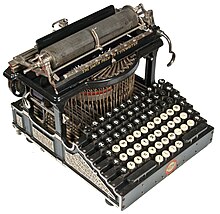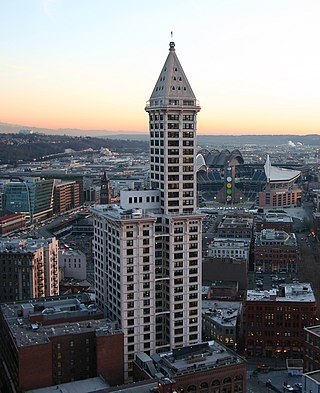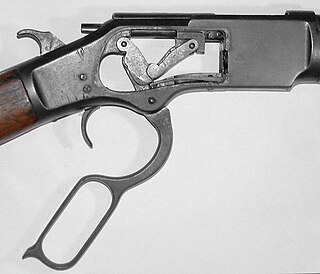Lyman Cornelius Smith (1850–1910) was an American innovator and industrialist. He is buried in a mausoleum in Oakwood Cemetery in Syracuse, New York.
Lyman Cornelius Smith (1850–1910) was an American innovator and industrialist. He is buried in a mausoleum in Oakwood Cemetery in Syracuse, New York.


L.C. Smith's first business venture occurred in 1873, when he opened a livestock commission in New York City. The business failed within two years. Undeterred, Smith next attempted to establish a lumber business in Syracuse in 1875. His success in lumber was limited. Again on the verge of financial failure, Smith decided to enter into the lucrative business of producing firearms. Although he and members of his family manufactured guns, they are not the 'Smith' from Smith & Wesson. Instead, Lyman Smith was the namesake of the famous L.C. Smith Shotgun. In 1877, L.C. and his older brother Leroy joined forces with an established firearms designer, William H. Baker, to form W.H. Baker & Co., and for the next three years, the firm produced Baker designed shotguns. However, in 1880, Leroy Smith and W.H. Baker left the company, and founded Ithaca Gun Company. The defection of Leroy Smith and Baker from the company did not hamper business, as they were replaced by Smith's younger brother, Wilbert, and a new designer Alexander T. Brown. The company was renamed the L.C. Smith Shotgun Company of Syracuse and went on to produce several popular breech-loading shotguns. In 1886, the company produced its first hammerless shotgun. This proved to be their most successful design. Despite the success of the company, Smith decided to sell the manufacturing rights for the entire line of L.C. Smith shotguns to Hunter Arms Company in 1889. Hunter Arms would produce the line until 1945, when they sold it to Marlin Firearms Company. Marlin halted production of L.C. Smith shotguns in 1950. They briefly revived the brand in 1967, before retiring it for good in 1972.


Smith later went on to found the Smith-Premier Typewriter Company, which would later become Smith-Corona Typewriter Company. Smith Corona or the SCM Corporation is a US typewriter and calculator company. The company experienced a decline in sales since the mid-1980s upon the introduction of PC-based word processing. Its competitors include Brother, Olivetti and IBM.
He was a presidential elector in the 1896 presidential election. [1]
In 1900, Smith donated nearly $75,000 to erect an engineering building at Syracuse University, and the L.C. Smith College of Engineering and Computer Science at Syracuse was named after him. [2] [3] Smith was a major financial booster of Syracuse rowing. [4] [5] [6]
He also funded the Smith Tower in Seattle, WA. [7]

Smith & Wesson Brands, Inc. (S&W) is an American firearm manufacturer headquartered in Maryville, Tennessee, United States.

Smith Tower is a skyscraper in the Pioneer Square neighborhood of Seattle, Washington, United States. Completed in 1914, the 38-story, 462 ft (141 m) tower was among the tallest skyscrapers outside New York City at the time of its completion. It was the tallest building west of the Mississippi River until the completion of the Kansas City Power & Light Building in 1931. It remained the tallest building on the U.S. West Coast for nearly half a century, until the Space Needle overtook it in 1962.

E. Remington and Sons (1816–1896) was a manufacturer of firearms and typewriters. Founded in 1816 by Eliphalet Remington in Ilion, New York, on March 1, 1873, it became known for manufacturing the first commercial typewriter.
The Winchester Model 1897, also known as the Model 97, M97, Riot Gun, or Trench Gun, is a pump-action shotgun with an external hammer and tube magazine manufactured by the Winchester Repeating Arms Company. The Model 1897 was an evolution of the Winchester Model 1893 designed by John Browning. From 1897 until 1957, over one million of these shotguns were produced. The Model 1897 was offered in numerous barrel lengths and grades, chambered in 12 and 16 gauge, and as a solid frame or takedown. The 16-gauge guns had a standard barrel length of 28 in (71 cm), while 12-gauge guns were furnished with 30 in (76 cm) barrels. Special length barrels could be ordered in lengths as short as 20 in (51 cm) or as long as 36 in (91 cm). Since the time the Model 1897 was first manufactured, it has been used to great effect by American military personnel, law enforcement officers, and hunters.
Remington Arms Company, LLC was an American manufacturer of firearms and ammunition. It was formerly owned by the Remington Outdoor Company and broken into two companies, each bearing the Remington name. The firearms manufacturer is Remington Arms owned by RemArms LLC, and the ammunition business is Remington Ammunition owned by Vista Outdoor Inc.

A lever action is a type of action for repeating firearms that uses a manually operated cocking handle located around the trigger guard area that pivots forward to move the bolt via internal linkages, which will feed and extract cartridges into and out of the chamber, and cock the firing pin mechanism. This contrasts to other type of repeating actions such as the bolt-action, pump-action, semi-automatic, fully automatic, and/or burst mode actions. A firearm using this operating mechanism is colloquially referred to as a levergun.
Sturm, Ruger & Company, Inc., better known by the shortened name Ruger, is an American firearm manufacturing company based in Southport, Connecticut, with production facilities also in Newport, New Hampshire; Mayodan, North Carolina; and Prescott, Arizona. The company was founded in 1949 by Alexander McCormick Sturm and William B. Ruger and has been publicly traded since 1969.
Pump action is a type of manual firearm action that is operated by moving a sliding handguard on the gun's forestock. When shooting, the sliding forend is pulled rearward to eject any expended cartridge and typically to cock the hammer or striker, and then pushed forward to load a new cartridge into the chamber. Most pump-action firearms use an integral tubular magazine, although some do use detachable box magazines. Pump-action firearms are typically associated with shotguns, although it has been used in rifles, grenade launchers, as well as other types of firearms. A firearm using this operating mechanism is colloquially referred to as a pumpgun.
The Ithaca Gun Company is a manufacturer of shotguns and rifles originally established in Ithaca, New York, in 1880.
Marlin Firearms is an American manufacturer of semi-automatic, lever-action and bolt-action rifles. In the past the company made shotguns, derringers, and revolvers. Marlin owned the firearm manufacturer H&R Firearms. In 2007, Remington Arms, part of the Remington Outdoor Company, acquired Marlin Firearms. Remington produced Marlin-brand firearms at its Kentucky and New York manufacturing facilities. In 2020, Sturm, Ruger & Co. bought the Marlin business from bankrupt Remington Outdoor Company.
Smith Corona is an American manufacturer of thermal labels, direct thermal labels, and thermal ribbons used in warehouses for primarily barcode labels.
The Browning Automatic 5, most often Auto-5 or simply A-5, is a recoil-operated semi-automatic shotgun designed by John Browning and manufactured by Fabrique Nationale de Herstal. It was the first successful semi-automatic shotgun design, and remained in production until 1998. The name of the shotgun designates that it is an autoloader with a capacity of five rounds, four in the magazine and one in the chamber. Remington Arms and Savage Arms sold variants called the Remington Model 11 and Savage Model 720 that were nearly identical but lacked the magazine cutoff found on the Browning.

The Union Trust Building is a commercial building in Seattle, Washington, United States. Located in the city's Pioneer Square neighborhood, on the corner of Main Street and Occidental Way South, it was one of the first rehabilitated buildings in the neighborhood, which is now officially a historic district. In the 1960s, when Pioneer Square was better known as "Skid Road", architect Ralph Anderson purchased the building from investor Sam Israel for $50,000 and set about remodeling it, a project that set a pattern for the next several decades of development in the neighborhood. Anderson also rehabilitated the adjacent Union Trust Annex.
Syracuse Arms Company was a firearms manufacturing company located in Syracuse, New York that produced firearms between 1888 and 1908. They are best known for their shotguns.

O. F. Mossberg & Sons is an American firearms manufacturer, specializing in shotguns, rifles, scopes, and pistol accessories.
Hopkins & Allen Arms Company was an American firearms manufacturing company based in Norwich, Connecticut, that was founded in 1868 by Charles W. Allen, Charles A. Converse, Horace Briggs, Samuel S. Hopkins and Charles W. Hopkins. The Hopkins brothers ran the company's day-to-day operations until it went bankrupt in 1916 and was subsequently bought by Marlin-Rockwell.

The Colonial Hotel is a historic building in Seattle located at 1119-1123 at the southwest corner of 1st Avenue and Seneca Streets in the city's central business district. The majority of the building recognizable today was constructed in 1901 over a previous building built in 1892-3 that was never completed to its full plans.
The Smith & Wesson Model 916 is a pump-action 12-gauge shotgun produced by Smith & Wesson during the 1970s.

The Interurban Building, formerly known as the Seattle National Bank Building (1890–1899), the Pacific Block (1899–1930) and the Smith Tower Annex (1930–1977), is a historic office building located at Yesler Way and Occidental Way S in the Pioneer Square neighborhood of Seattle, Washington, United States. Built from 1890 to 1891 for the newly formed Seattle National Bank, it is one of the finest examples of Richardsonian Romanesque architecture in the Pacific Northwest and has been cited by local architects as one of the most beautiful buildings in downtown Seattle. It was the breakthrough project of young architect John Parkinson, who would go on to design many notable buildings in the Los Angeles area in the late 19th and early 20th century.

The Syracuse University College of Engineering and Computer Science is one of the 13 schools and colleges of Syracuse University. The College offers more than 30 programs in four departments – Biomedical and Chemical Engineering; Civil and Environmental Engineering; Electrical Engineering and Computer Science; and Mechanical and Aerospace Engineering and The College.
{{cite book}}: CS1 maint: location missing publisher (link)